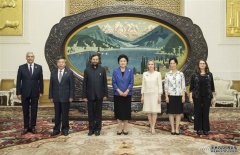Feature: Chinese language learning on the rise in Hungary
BUDAPEST, Sept. 30 (Xinhua) -- Balazs Sun Nursery, located in the remote suburbs of Budapest, is still somewhat of a rarity in Europe -- it is a private school which offers Chinese language education for children.
Although there are only eight students in total, four of them are studying Chinese, some of them still toddlers. Yet this phenomenon is becoming increasingly common and shows that learning the Chinese language is on the rise in Hungary.
One recent morning, a Xinhua reporter visited the nursery. "Da (big), xiao (small), duo (many)..." Sounds of reading in Chinese could be heard from the classroom.
So why are the nursery's students starting to learn Chinese at this young and tender age? Antonia Piczek, the director of the nursery, told Xinhua that the parents believed that their children could easily pick up foreign languages before they reach the age of seven.
"Hungarian children have their Chinese companions here. Hungarian parents have gradually fostered their interest in Chinese, therefore, they have decided on sending their children to learn Chinese, instead of English and German which are the traditional foreign languages taught in the country," she said.
Qiao Wen, the Chinese teacher for the four children in this nursery, is also the headmaster of the Golden Bridge Chinese language school. She has provided Chinese lessons twice a week for more than a year now. She said there were more than 60 students in her school, including children and adults, and most of them were Hungarians.
"Hungarian children are educated in traditional Chinese culture because their parents hope their children can have the opportunity of studying in China in the future," said Qiao. "It gives me confidence when I work for improving Chinese language education, which is valuable."
In 2004, the governments of China and Hungary built a bilingual school together, a unique full-time school that teaches Chinese and local languages in Central and Eastern Europe (CEE).
In the beginning, the bilingual school only had four grades with 87 students. Following the historic opportunities of Hungary's "Opening to the East" policy and China's Belt and Road Initiative, the school just established a senior high department this September to meet local demand for learning Chinese. Currently, the school has nine grades and more than 390 students, with two thirds of them being local and one third Chinese.
Mate Kollmann, an eighth grader, said he likes Chinese culture and wants to study and work in China in the future. Zsofia Tamara Olah, a girl in the same grade, said the Chinese language is the most difficult one to learn but she is sticking to her Chinese language studies because of her interest in Chinese culture and history.
Not only Chinese language learning but as a consequence Chinese language teaching is flourishing in Hungary as well, partly because of efforts by the Confucius Institute. Now, there are four Confucius Institutes in Hungary, including the Confucius Institute of Eotvos Lorand University (ELTE), the oldest one which was established 10 years ago. In the beginning, it only had one permanent teacher and one volunteer teacher, but now its staff has grown to 32 and the number of enrolled students has reached 2,000.
"China has been developing rapidly in the last 20 years, so everybody wants to study Chinese. Chinese language learners have more opportunities to find good jobs later on," said Imre Hamar, the Hungarian dean of ELTE, adding that many students are studying Chinese expressly for the purpose of good career opportunities.















